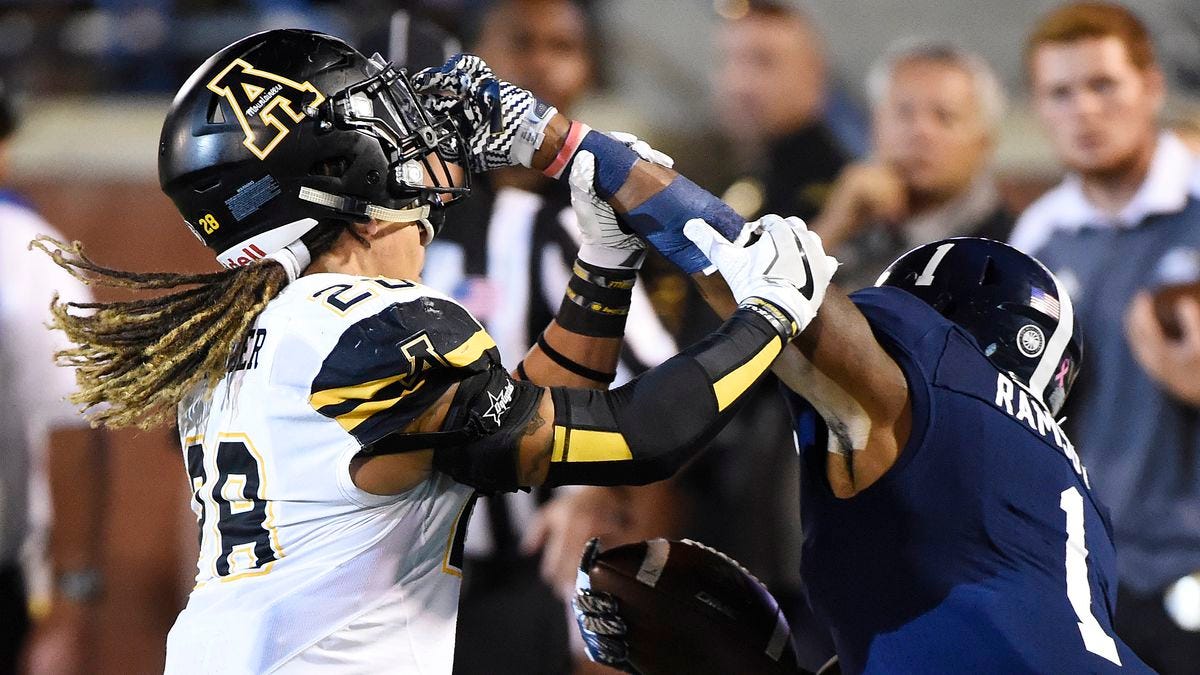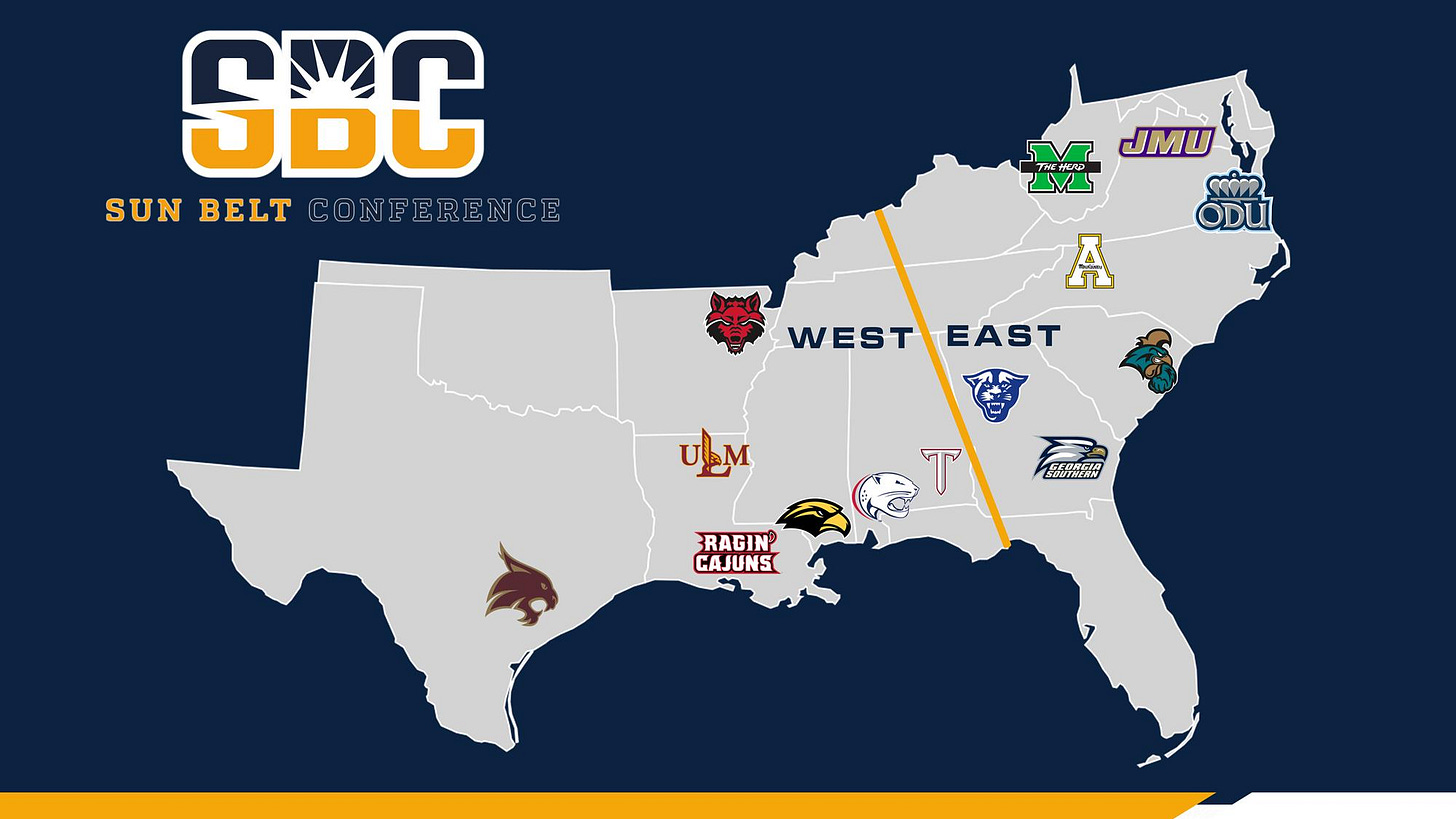The Sun Belt: the conference that did realignment right
The league did what so many fail to do so often: it built a conference focused on regionality and rivalries. And it has worked
In recent years, the idea of a conference – a group of like-minded and similarly resourced institutions from roughly the same part of the country – has become harder to define.
The ACC features members like Louisville and Notre Dame that are hundreds of miles from the namesake Atlantic Coast. The Big Ten has 14 members and hasn’t had 10 since 1993. The Big East, may it rest in peace, was at one point 12 years ago all set to add San Diego State and Boise State.
The effect of this movement, absurd as it may have seemed in the moment, has been negligible. People still care about their teams and still watch games, which ramps up the television value of these schools and the leagues in which they play.
What has happened in the most recent rounds of realignment has been a little more worrisome and raised the question of what, exactly, it is that we’re trying to do here.
Starting next year, four West Coast schools – USC, UCLA, Oregon and Washington – will be members of the Big Ten, a league that has never had a school west of Lincoln, Nebraska. The Big 12, once limited to Texas and the plains states, will span across three time zones, as far east as West Virginia and as far west as Tempe, Arizona. The aforementioned ACC is now going to stretch all the way to Texas and California with the additions of Stanford, Cal and SMU starting next year. And, because of those larger tectonic shifts, an entire region of the country won’t have an entity representing it at the highest level of major college sports.
The widespread movement created a domino effect with conferences that just lost schools looking elsewhere to replenish their ranks. Between the FBS and FCS levels alone, 19 different leagues were impacted in some way.
Among all of those conferences, there’s one in particular that didn’t become deformed or diluted, but embodied what it is that a conference should be.
Allow me to introduce you to the Sun Belt.
While the league didn’t poach some of the highest-profile athletic powers nationally, it reformed itself by tapping into two things that can sometimes go overlooked in conference expansion and realignment – regionality and on-field competitiveness.
The conference, which was founded in 1976 and began sponsoring football in 2001, has a frenetic, sometimes dizzying history. Its membership has been transient, with 35 different schools having been a part of the league in some form since its founding.
In recent years, however, it has found something that clearly works. With recent additions of Marshall, James Madison, Old Dominion and Southern Miss, the 14-team league has a solid geographic identity, almost entirely within the confines of the American southeast and parts of the southwest. After losing the likes of Florida International, North Texas, Florida Atlantic, Middle Tennessee and Western Kentucky over the past 11 years, it didn’t panic in a fight for survival. Instead, it made measured and sensible additions to not only maintain the league’s overall quality, but improve it.
The results have been commendable. Last season, the Sun Belt saw a 50% increase from the previous year in all-Americans from the conference and the league had seven of its teams make a bowl game, placing it behind only the SEC, Big Ten, ACC and Big 12 among FBS conferences.
How did it get to that enviable position? By going against many of the forces that have dictated modern-day conference realignment.
It stressed regionality
This wasn’t always the case for the Sun Belt. Utah State was in the conference from 2003-05 and as recently as 2017, the league’s football membership included Idaho and New Mexico State.
In recent years, that has changed.
All of the additions the conference has made in the past 10 years are concentrated in the, well, Sun Belt – Georgia State, Texas State, Appalachian State, Georgia Southern, Coastal Carolina, James Madison, Marshall, Old Dominion and Southern Miss.
That intense regional identity was magnified in 2018, when the league moved to a divisional format. In many leagues, particularly in the Power Five, divisions are a contrivance those conferences are increasingly doing away with as they expand. In the Sun Belt, though, they made a conference footprint stretching from the Virginia coast to south Texas much more manageable while helping strengthen the history and connection between programs in roughly the same part of the country.
The league’s scheduling format fortifies that. In an eight-game conference slate, a team plays all six opponents within its division, as well as two rotating foes from the other division. For both the east division – which has schools in West Virginia, Virginia, North Carolina, South Carolina and Georgia – and the west division – whose members are in Alabama, Mississippi, Louisiana, Arkansas and Texas – it creates two ingredients necessary for any intensity to develop: familiarity with a program and a physical proximity to it (and its fans).
Being a more regionalized outfit has a practical purpose, too. With the schools closer to one another, those institutions with shallower pockets aren’t stuck with onerous travel budgets, the kinds that can’t be made up for because of lucrative conference payouts funded by opulent television contracts.
Though it’s not tied to regionality, the Sun Belt also lost its two non-football members, Arkansas Little Rock and Texas Arlington, in advance of the 2022-23 season, giving the league a consistency that has harmed other conferences in the past.
Contrast that with other Group of Five Conferences, particularly Conference USA.
A league that for years was on even, if not higher, footing than the Sun Belt covers roughly the same geographic stretch as the Sun Belt, but because of its low membership count, with only nine schools, its teams are much more scattered and they’re not clustered into divisions. Only one state, Texas, has more than one team in the conference and the league sports only one earnest rivalry – UTEP and New Mexico State, the latter of which is in its first year in the league.
Those advantages the Sun Belt possesses even extend to leagues that are generally thought of to be better than it. The American Athletic Conference ranges from Philadelphia to Texas. It, like Conference USA, doesn’t have divisions, even though it has 15 members and could easily do so. It also features schools that are football-only members (Navy and, in the next couple of years, Army) and others that are in the conference for every sport but football (Wichita State), sapping it of the exposure that breeds the intense feelings that distinguish college sports.
It correctly identified potential in new members
It’s a lesson several conferences have learned the hard way – expansion doesn’t guarantee progress. You can add members, sure, but they have to be the right ones. If not, you’re stuck with a metaphorical albatross that, legally speaking, is quite difficult to shake.
Keep reading with a 7-day free trial
Subscribe to The Front Porch to keep reading this post and get 7 days of free access to the full post archives.





